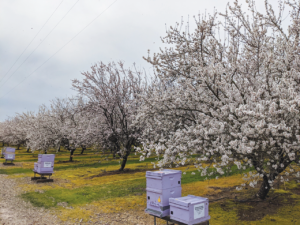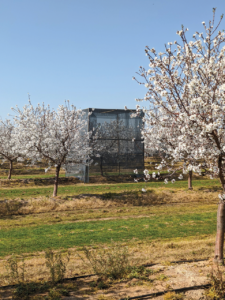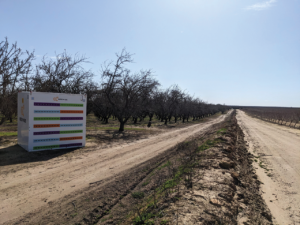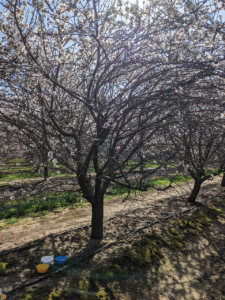
January/February 2024
Data and novel technologies
While pecans, walnuts, hazelnuts and pistachios are wind-pollinated, and macadamia nuts seem to benefit from presence of pollinating bees(1), successful almond production heavily relies on cross-pollination by foraging honeybees. Almond bloom in California is considered the largest pollination event that spans approximately six weeks in February and March.

During this time California becomes home to approximately 1.5 million honeybee colonies(2). Current recommended stocking rate is two colonies per acre, at the price per colony being about $200. However, these numbers fluctuate from year to year depending on a number of factors such as the needs of growers (e. g., old orchards pulled or new orchards becoming nut bearing), the severity of colony losses due to a number of biotic and abiotic factors or economics.
STOCKING RATE
In an attempt to reduce dependence on bees for successful pollination and associated cost of hive rentals, plant breeders have developed self-fertile almond varieties such as Independence, Shasta and Pyrenees. However, recent research, including research by myself and my collaborators, shows that trees indeed benefit significantly from presence of honeybees, and in some cases can increase the nut set by 60% resulting in 20% increase in nut meat yield(3).

Currently, we are completing the analysis of data that will help answer the question of what is the optimal stocking rate for self-fertile varieties. This will allow growers to make the most economically viable decision for their operation. Upcoming research will use historical data and field experiments to update colony stocking guidelines for conventional almond varieties. If you would like to participate in this effort please contact me at elnino@ucdavis.edu.
NOVEL TECHNOLOGIES
Novel technologies are also garnering a lot of attention and interest from both growers and beekeepers. Technological advances have led to the expansion of precision beekeeping and attempted implementation of robotic housing for multiple hives, in-hive sensor technology, hive cameras, as well as various feedants to increase pollination efficiency. Use of robotics is intended to eventually reduce labor cost inputs and allow beekeepers to monitor hive activity, strength and preemptively intervene with appropriate management actions to maintain colony health.
Use of cameras and in-hive sensors measuring temperature, humidity, gas levels and auditory signals, might be of interest to growers as tools to track colony activity during pollination. Products fed to bees in order to enhance their ability to forage at lower temperatures and those that improve attraction to the specific crop(4) are also being researched. While these technologies are still under development, in the not so distant future they might be synergized into bee-safe, efficient and cost- effective pollination management plans.

APICULTURE RESEARCH
Apiculture research still heavily focuses on characterizing and ameliorating various environmental stressors with an ultimate goal of reducing colony losses. Unfortunately, beekeepers are still experiencing high losses and the latest national beekeeper survey (2022-2023) reported 48.2% average annual colony mortality. Pests, pathogens, pesticides, poor nutrition are most commonly quoted causes of colony death.

Beekeepers report the parasitic varroa mite as one of the leading stressors as it suppresses bee’s immune response and transmits viruses. The research community is diligently working on developing novel ways to manage varroa as they can rapidly develop resistance to available pesticides.
Pathogens to which honeybees are exposed are many and range from viruses to bacterial diseases and fungi. There are very few options for treatment of such diseases other than the use of antibiotics for bacterial disease, making it an additional challenge for beekeepers. Inappropriately used pesticides can also lead to colony mortality or can cause sublethal effects such as memory disruption.

When foragers are not able to properly remember where the plant food source is or how to return to the hive and recruit other foragers, it can severely negatively impact pollination efficiency. Pesticides will remain a crucial component of agricultural production and we should do our best to protect pollinators while utilizing pesticides as a part of an integrated pest management approach.
The Almond Board of California has an excellent set of guidelines as to how to reduce potential negative impacts from pesticides in orchards which you can review online.
Another useful resource to help select less bee- harmful pesticides is the University of California IPM Bee Precaution Pesticide Ratings database tool. If you are in California please remember to check for hive locations in your vicinity and notify the beekeeper prior to pesticide applications.
SUPPLEMENTAL FORAGE
Habitat loss and particularly access to plentiful forage has emerged as another impactful stressor. This is particularly troubling since research shows that negative effects of many of the above described stressors can be alleviated when bees have access to optimal nutrition.
<<Read more about Niño’s ongoing research>>
Prior research supports the idea that planting supplemental forage within almond orchards can increase production of brood which triggers higher numbers of foragers flying out and pollinating, and have long lasting beneficial impacts on colonies long after almond pollination. A common concern by growers is the supplemental forage will pull the bees away from their intended crop target, but the research shows that this is not the case(5).
Project Apis m. (projectapism.org) has a number of resources for planting bee forage. Lastly, growers can help further support bee health by providing access to clean water sources, allowing easy access to beekeepers to come in and manage colonies as needed, and allowing bees to be released in a timely manner when the latest blooming varieties are at 90% petal fall.
Disclaimer: Mention of any product or company does not constitute an endorsement.
References
- Tavares, Jane M., Villalobos, Ethel M., Wright, Mark G. (2015) Proceedings of the Hawaiian Entomological Society 47: 35-49.
- USDA – NASS (2023) Colony Loss Survey and resulting Honey Bee Colonies report
- Sáez, A., Aizen, M.A., Medici, S. et al. Bees increase crop yield in an alleged pollinator-independent almond variety. Sci Rep 10, 3177 (2020). doi.org/10.1038/s41598-020-59995-0
- Farina, W.M., Palottini, F., Estravis- Barcala, M.C. et al. Conditioning honeybees to a specific mimic odor increases foraging activity on a self- compatible almond variety. Apidologie 54, 40 (2023). doi.org/10.1007/s13592- 023-01019-7
- Ola Lundin, Kimiora L. Ward, Derek R. Artz, Natalie K. Boyle, Theresa L. Pitts Singer, Neal M. Williams, Wildflower Plantings Do Not Compete With Neighboring Almond Orchards for Pollinator Visits, Environmental Entomology, Volume 46, Issue 3, June 2017, Pages 559–564.







